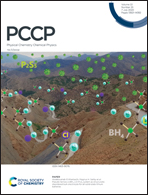A theoretical study of the addition of CH2OO to hydroxymethyl hydroperoxide and its implications on SO3 formation in the atmosphere†
Abstract
The reaction of hydroxymethyl hydroperoxide (HMHP, HOCH2OOH) with the simplest Criegee intermediate, CH2OO, has been examined using quantum chemical methods with transition state theory. Geometry optimization and IRC calculations were performed using the M06-2X, MN15-L, and B2PLYP-D3 functionals in conjunction with the aug-cc-pVTZ basis set. Single point energy calculations using QCISD(T) and BD(T) with the same basis set have been performed to determine the energy of reactants, reactive complexes, transition states, and products. Rate coefficients have been obtained using variational transition state theory. The addition of CH2OO on the three different oxygen atoms in HMHP has been considered and the ether oxide forming channel, CH2OO + HOCH2OOH → HOCH2O(O)CH2OOH (channel 2), is the most favorable. The best computed standard enthalpy of reaction (ΔHRX298K) and zero-point corrected barrier height are −20.02 and −6.33 kcal mol−1, respectively. The reaction barrier is negative and our results suggest that both the inner and outer transition states contribute to the corresponding overall reactive flux in the tropospheric temperature range (220 K to 320 K). A two-transition state model has been used to obtain reliable rate coefficients at the high-pressure limit. The pressure-dependent rate coefficient calculations using the SS-QRRK theory have shown that this channel is pressure-dependent. Moreover, our investigation has shown that the ether oxide formed may rapidly react with SO2 at 298 K to form SO3, which can, in turn, react with water to form atmospheric H2SO4. A similar calculation has been conducted for the reaction of HMHP with OH, suggesting that the titled reaction may be a significant sink of HMHP. Therefore, the reaction between CH2OO and HOCH2OOH could be an indirect source for generating atmospheric H2SO4, which is crucial to the formation of clouds, and it might relieve global warming.



 Please wait while we load your content...
Please wait while we load your content...